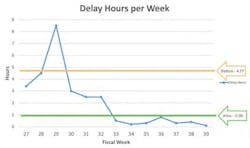A variety of efforts across industry have, for decades now, sought ways to better connect front office executive decision making to plant floor production operations. Those efforts have ranged from numerous middleware hardware and software products to company-wide Big Data analyses.
Corey Vodvarka, director of manufacturing solutions at Parsec Automation Corporation, suggests that there may be a better way—via overall equipment effectiveness (OEE). Though typically viewed as an operations tool for production improvement, Vodvarka says, “OEE is more than a calculation, it is the cornerstone of strategy in continuous improvement. OEE is a way for strategic leaders to promote action and streamline accountability in the plant. Taking advantage of OEE accomplishes both of these tasks by allowing operations to reach production goals and executives to inspire teams.”
To better explain his point, Vodvarka suggests looking at downtime as an example. He says that, if you ask an operator to note each stoppage during a shift on a single line, if those stoppages average 60 seconds or less—as many stoppages do—the operator may not consider such stops as official downtime. They may also not consider those stoppages as being worthy of note if there was no need to call maintenance to get the line back up and running.
Such discrepancies in perception support the need for manufacturing operations management (MOM) software, which extracts data directly from the machine. MOM software “can plug straight into existing PLCs, HMIs and other platforms to capture OEE information in a significantly more effective manner than humans.”
Data Alone Is Not Enough
But Vodvarka cautions that having the correct data alone is not enough.
If the right information is gathered but not consumed immediately, it may be too late to make effective changes to your operations.
“Production requires challenges to be caught and fixed as they arise, in real-time,” says Vodvarka. “If performance is down, and negatively affecting production, the team must be poised to fix it. This is exactly where manual efforts can fall short.”
Such realities of manufacturing operations are why Vodvarka contends that the strategy around OEE must “tie directly to value, or it will fail. Managers must be willing to get involved to ensure their objectives are met. These direct efforts shape the team and produce the focus required to improve business processes.”
To connect top floor goals to plant floor operations via OEE, Vodvarka says the first step is to see where your team stands today, benchmark your current performance, and assign a leader to cement commitment and optimize overall efficiency.
“Remember, the aim is to add value by leveraging OEE to improve business practices,” he says. “Consider assigning direct responsibility to an ‘issue champion’ who can perform regular production reviews and advance plant performance.”
Creating a leader and following this path establishes:
- A common focus to identify losses and establish priorities; and
- Actionable changes that can be applied to the areas that are experiencing issues.
“This is precisely where OEE generates value and incites change,” says Vodvarka. “By identifying issues, engaging operations and exceeding expectations.”
How can OEE be strategic?
As a metric of loss, OEE sheds light on where to apply resources effectively, maximizing profit potential in the planning and budgeting process.
Armed with insight via OEE, leaders can exist anywhere in the organization, cutting costs and creating transparency throughout the supply chain, says Vodvarka. “As a measure of productivity, OEE uniformly connects a network of plants, reducing critical areas of waste and redundancy. The result is vital visibility into every system on the plant floor in one, simple tool. Islands of automation are eliminated as OEE creates a common conversation among systems, capturing the business intelligence leaders need to make essential decisions.”
Proof is in the Results
Vodvarka cites the results experienced by an international food company as a tangible, real world example of how OEE can be the connection point for enterprise and plant floor operations to improve operations and achieve business goals.
Using Parsec’s TrakSys software, Vodvarka says this food company:
- Increased OEE by 13.5 percent;
- Improved adjusted productivity 6.36 percent; and
- Saved $84,000 in total labor costs per line in a single plant.
Editor's note: PMMI (the parent company of Automation World) offers an OEE benefits calculator that can help you get started on the path toward applying OEE as a strategic tool for improvement. Learn more here.
About the Author
David Greenfield, editor in chief
Editor in Chief

Leaders relevant to this article:
